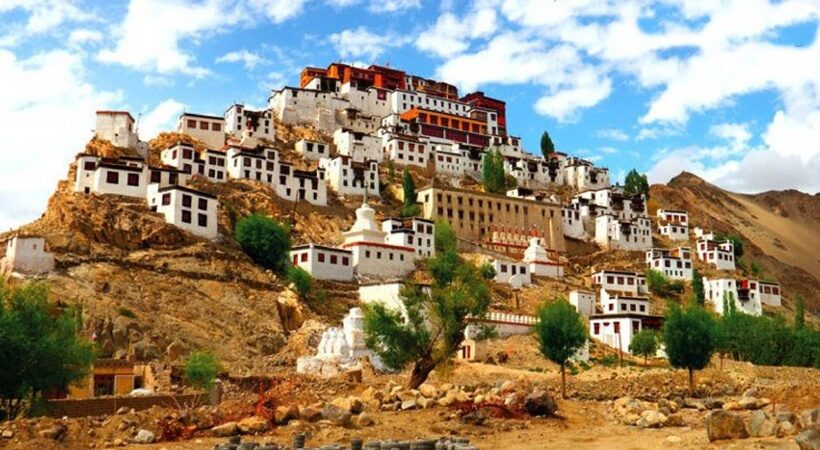Roughly 65 km from Leh on the banks of the Indus River, lay the beautiful Alchi Monastery or Alchi Gompa (monastery and temple complex). The monastery at the Alchi village is regarded as one of the oldest Buddhist monasteries in Ladakh. As per scholars, the monastery was constructed in the 11th century. The monastery is known for its intricate murals and their syncretic intermixing of Tibetan and Kashmiri art styles.

Image Credits: himalayanbuddhistart.wordpress.com
The temple is adorned with mesmerizing coloured patterns scrolling across the wood beams, whereas the temple’s walls are covered with hundreds of small seated Buddhas, finely painted in ocher, black, green, azurite and gold. One of the major attractions of the monastery is the 17-feet high painted statue of the Bodhisattva Maitreya. With four arms and a head topped with a spiked crown, the figure of the Bodhisattva has an imposing effect on the viewer. Two hulking statues, one embodying compassion and the other wisdom, stand in niches on sidewalls, attended by garishly coloured sculptures depicting flying goddesses and minor deities. Each massive figure wears a dhoti, a kind of sarong, embellished with minutely rendered scenes from the life of Buddha.

Image Credits: Research Gate
The Alchi murals, their vibrant colours and beautifully rendered forms rivalling medieval European frescoes, have drawn a growing number of tourists from around the world. The murals depict complex philosophical ideas to assist the monks in their spiritual journey. The Yoga Tantra form of Buddhism is dominated by a transcendental Buddha known as Vairochana, who is associated with the historical Buddha Shakyamuni. Then there are four Buddhas which are associated with the four cardinal directions. The red Amitabha of the west, the blue Akshobhaya of the east, the green Amoghasiddhi of the north and the yellow Ratnasambhava of the south revolve around the sparkling white figure of Vairochana. All five Buddhas are known as the Tathagata Buddhas.
In the Yoga Tantra cosmology, each of these Buddhas heads a family that includes counterpart goddesses and Bodhisattvas. It is this system that is elaborately represented as a mandala consisting of concentric circles locating Vairochana at the centre, i.e. the heart of the cosmology and ritual. The various concentric circles of a mandala represent the progression to the core(enlightenment). The Alchi group is a stunning form of Tibetan religious art that illustrates complex Buddhist philosophies. Moreover, the intricate depictions also serve as a tool for contemplation and meditation.
Every year in June, a three-day Hemis festival is celebrated in the region where the culture of Ladakh and its various traditions are proudly displayed with splendour. This makes the festival an ideal occasion to explore Alchi and its culture.



















